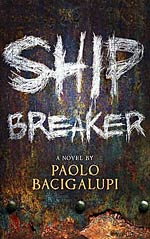
![]() Rhondak101
Rhondak101
6/14/2012
![]()
Paolo Bacigalupi's Ship Breaker has won several awards, the Locus Award for Best Young Adult Book and the Michael L. Printz Award, given by the American Library Association. In addition, it was a finalist for the National Book Award for Young People's Literature. I have not read much YA literature, and the books that I have read seemed to have universal appeal for young and older adults. This book seemed much more YA to me because it tries very hard to be didactic rather than letting learning evolve through plot and character.
The book is set in a dystopian future in which global warming has caused cataclysmic changes in the environment. The environmental changes precipated the collapse of a fossil-fuel dependent America. The population of America seems to have segmented into two classes, the very poor and the very rich, who rarely meet one another. (The middle class really does not appear in this book.) A new species of genetically-engineered humans, called half-men, provide many of the services for the rich that were previously dependent on the middle class. The half - men we encounter in this book serve as security officers. They are created by engineering human eggs with dog, tiger and hyena DNA. This creates an intelligent creature whose loyalty to its master is genetically guaranteed. This feature ensures that this super-human slave cannot rebel against its master. When the master dies, the half-man mourns until it dies. In this community, people can only survive through the loyalty of others, genetic or otherwise.
Ship Breaker shows what happens when rich and poor meet and look beyond class allegiances to find compassion and create new loyalties. Teen-ager Nailer Lopez works as a ship breaker on a Gulf Coast re-defined by global warming. The crews dismantle ships for salvage for a large corporation. They sleep in shacks along the beach and live from hand to mouth. Because Nailer is small, his job is to crawl through the ducts and conduits of the ships and pull out the copper wiring. In many ways, Nailer is like a Victorian chimney sweep relocated in another time: he worries that he will out grow his usefulness. All of the ship breakers wish for a lucky strike, an independent discovery of anything that they can sell to buy their way out of their indentured servitude. Just a few days after Nailer earns the nickname "Lucky Boy," surviving a fall into tanker filled with waste oil, he finds the salvage of a lifetime, a rich man's clipper ship beached during a storm. However, when he and his friend Pima begin exploring the ship, they discover that the rich young heiress traveling on the clipper ship is alive, barely. Nailer's recent near death experience leads him to compassion, even as Pima and his brain tell him that abandoning or killing the girl will allow them a clear path to a lucky strike.
Through mutual compassion, Nita, the heiress, and Nailer try to save one another from their respective circumstances. However, no one can hide a big, beached ship and soon Nailer's abusive and drug addicted father, Richard, and his crew capture Nita, Pita and Nailer. They learn that Nita is on the run from her uncle who is trying to kidnap her so that he can force her father to give up leadership of the family business. Richard decides to keep her alive for his own ransom purposes, but when no-one comes to look for Nita, she realizes that Richard is ready to cut his losses. With the help of Pita's mother and Tool, a half-human who claims he has no master, a real anomaly in this world, Nailer and Nita escape to return Nita to her father. The journey these three mismatched beings take teaches them much about acceptance.
Bacigalupi creates a very interesting and nuanced world; however, he does not give this world the background or the exposition it deserves. In the first two-thirds of the book, the reader has to work hard to figure out the details of this world: how it works, how the world became as it is, and how its customs came to be. What is particularly frustrating is much of the explanation I desired occurs in the last hundred or so pages of the book. For example, we learn about Siberian and Inuit pirates:
"The pirates were bitter enemies of the trading fleets and perfectly willing to kill or sink an entire cargo as revenge for the drowning of their own ancestral lands. There were no polar bears now, and seals were few and far between.... And with the disappearance of the ice, the Siberians and the Inuit became a sea people" (257).
In addition, the readers learn that global warming is not the only cause of the drowned and destroyed coastal cities:
"Where'd they get the petrol?" [Nailer] asked.
"They got it from everywhere." Nita laughed. "From the far side of the world. From thebottom of the sea." She waved at the drowned ruins, and a flash of ocean. "They used to drill out there, too, in the Gulf. Cut up the islands. It's why the city killers [hurricanes] are so bad. There used to be barrier islands, but they cut them up for their gas drilling" (199).
I found these two glimpses of the larger world and its history intriguing and wish there had been more of them. I have not read any of Bacigalupi's other books, so I don't know if this lack of exposition is part of his style. Nevertheless, I'm intrigued by Bacigalupi's point of view so I will certainly read The Ship Breaker 's sequel, The Drowned Cities, which is set in this same world, and The Windup Girl (Nebula Winner, Campbell Winner, and Hugo Winner).